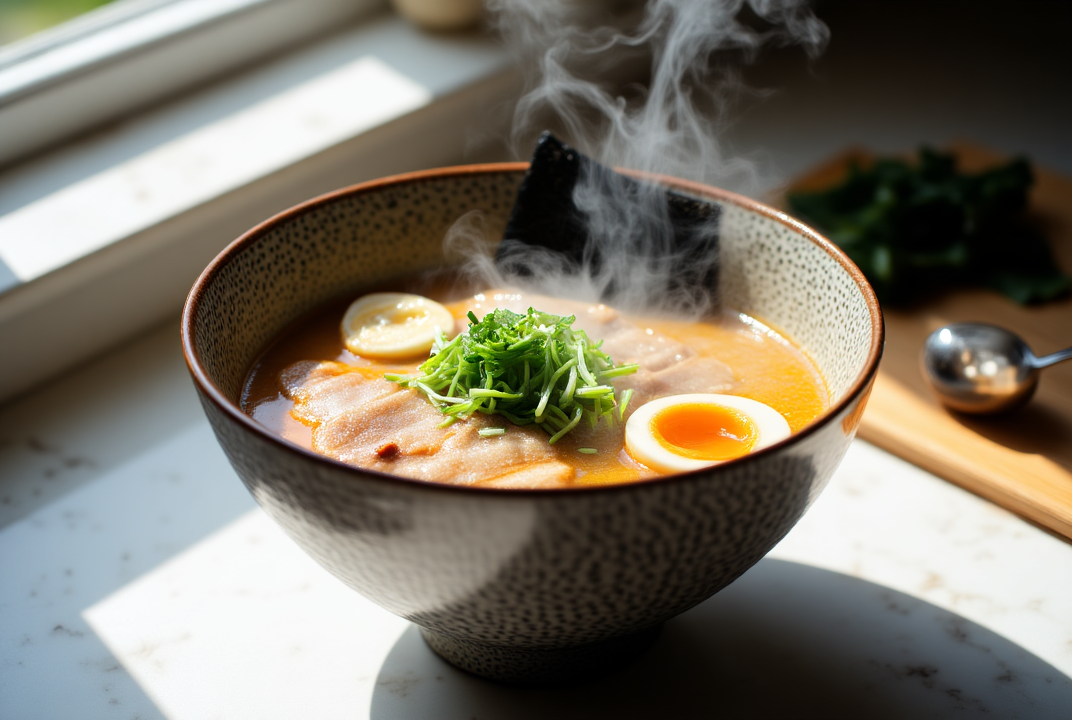
Ramen isn’t just a meal—it’s an adventure in a bowl, blending tradition, creativity, and comfort. Whether you’re looking to master a classic recipe or put your own spin on this beloved dish, our step-by-step approach makes homemade ramen accessible to everyone. Dive in and discover how easy (and fun) it can be to bring the flavors of your favorite ramen shop right to your own table.
What Is Ramen?
Ramen is a beloved Japanese noodle soup that combines wheat-based noodles with a savory broth, typically flavored with soy sauce, miso, or salt, and topped with a variety of ingredients like sliced pork, soft-boiled eggs, nori (seaweed), green onions, and bamboo shoots. Originally inspired by Chinese noodle dishes, ramen has evolved into a culinary icon in Japan and around the world, celebrated for its comforting flavors and endless customization options. Whether enjoyed as a quick meal or a carefully crafted specialty, ramen offers a delicious blend of textures and tastes that make it a favorite for food lovers everywhere.
What Makes Ramen One of the World’s Favorite Comfort Foods?
- Rich, Savory Broth: Ramen’s deeply flavorful broth—whether made with miso, soy sauce, or pork bones—offers a warming, satisfying base that soothes and comforts.
- Customizable Toppings: From tender slices of pork to marinated eggs, fresh vegetables, and crunchy nori, ramen’s endless topping options let everyone personalize their bowl.
- Perfectly Chewy Noodles: The springy, chewy texture of ramen noodles creates a satisfying bite that pairs perfectly with the broth and toppings.
- Balance of Flavors and Textures: Ramen brings together salty, umami-rich, and sometimes spicy flavors with a mix of soft, crunchy, and creamy textures, making every bite exciting.
- Nostalgic and Social Experience: Whether enjoyed solo as a quick meal or shared with friends at a bustling ramen shop, ramen evokes feelings of comfort, nostalgia, and connection.
How To Make Ramen: Step-by-Step
Step 1: Gather Your Ingredients
Start by assembling all the key components for your ramen. You’ll need ramen noodles (fresh or dried), broth base (such as chicken, pork, miso, or vegetable), and a selection of toppings like sliced pork (chashu), soft-boiled eggs, green onions, nori, bamboo shoots, and corn. Having everything prepped and ready will make the cooking process smooth and enjoyable.
Step 2: Prepare the Broth
The broth is the heart of any great ramen. In a large pot, simmer your chosen base—chicken, pork bones, or a combination—with aromatics like garlic, ginger, and onions. For a quick version, you can use store-bought broth enhanced with soy sauce, miso paste, or dashi. Let the flavors meld for at least 30 minutes, or longer for a richer taste.
Step 3: Cook the Noodles
Bring a separate pot of water to a boil and cook the ramen noodles according to the package instructions. Fresh noodles usually cook in just a couple of minutes, while dried noodles may take a bit longer. Drain the noodles well to prevent them from becoming soggy, and set them aside until you’re ready to assemble your bowl.
Step 4: Prepare the Toppings
While the broth simmers and the noodles cook, prepare your toppings. Soft-boil eggs and marinate them in soy sauce for extra flavor, slice cooked pork or chicken, chop green onions, and get your vegetables and nori ready. Toppings can be as simple or elaborate as you like, so feel free to get creative.
Step 5: Assemble Your Ramen Bowl
To serve, place the cooked noodles in a large bowl, ladle the hot broth over them, and arrange your chosen toppings on top. Finish with a sprinkle of sesame seeds, a drizzle of chili oil, or a dash of togarashi for extra flavor. Enjoy your homemade ramen immediately while it’s hot and comforting!
Can You Make Ramen Beef Bone Broth?
Yes, you can absolutely make ramen with beef bone broth, and it’s a delicious way to add rich, deep flavor to your bowl. Beef bone broth, like the one offered by Dr. Kellyann, is packed with nutrients and delivers a savory, umami base that pairs perfectly with ramen noodles and your favorite toppings. Whether you make your own broth from scratch or use a high-quality, ready-made option, beef bone broth creates a hearty, satisfying foundation for homemade ramen that’s both nourishing and full of robust taste. Learn more about Dr. Kellyann’s Ramen Beef Bone Broth.
What’s the Difference Between Traditional Ramen Broth and Bone Broth?
Traditional ramen broth is typically made by simmering chicken, pork, or a combination of meats with aromatics like garlic, ginger, and onions, often flavored with soy sauce, miso, or salt to create a balanced, savory base. Bone broth, on the other hand, is made by simmering animal bones—often beef or chicken—for an extended period, which extracts collagen, minerals, and nutrients, resulting in a richer, more gelatinous texture and deeper flavor. While both broths can be used for ramen, bone broth is prized for its nutritional benefits and hearty mouthfeel, whereas traditional ramen broth focuses more on layered flavors and a lighter, yet still satisfying, consistency.
What’s the Ideal Noodle-to-Broth Ratio?
The ideal noodle-to-broth ratio for ramen is typically about 1 part noodles to 2 parts broth, ensuring every bite is flavorful and well-balanced. This means for a standard serving, you’ll want enough broth to fully submerge the noodles while still allowing them to shine as the star of the bowl. Too many noodles can soak up the broth and make the dish heavy, while too much broth can dilute the flavors and leave the bowl feeling sparse. Striking the right balance ensures a satisfying ramen experience, where the noodles and broth complement each other perfectly in every spoonful.
Which Vegetables Complement Beef Bone Broth Best?
|
Vegetable |
Flavor Profile |
Why It Works With Beef Bone Broth |
Suggested Preparation |
|
Shiitake Mushrooms |
Earthy, umami-rich |
Deepens the savory notes and adds texture |
Sliced, sautéed or simmered |
|
Bok Choy |
Mild, slightly sweet |
Adds freshness and a crisp bite |
Halved or chopped, blanched |
|
Spinach |
Tender, slightly bitter |
Wilts beautifully and balances the richness |
Fresh, added at the end |
|
Green Onions |
Sharp, mildly sweet |
Brightens the broth and adds color |
Thinly sliced, raw or lightly cooked |
|
Bamboo Shoots |
Crunchy, mild |
Offers texture and subtle flavor |
Sliced, canned or fresh |
|
Carrots |
Sweet, earthy |
Adds natural sweetness and color |
Julienned or thinly sliced |
|
Corn |
Sweet, juicy |
Provides pops of sweetness and visual appeal |
Kernels, fresh or frozen |
|
Napa Cabbage |
Mild, slightly peppery |
Softens in broth and absorbs flavor |
Shredded, simmered |
What’s the Finishing Touch That Turns a Good Ramen Into a Restaurant-Quality One?
The finishing touch that elevates homemade ramen to restaurant-quality is the careful layering of garnishes and seasonings just before serving. A perfectly cooked ramen egg with a creamy, marinated yolk, a sprinkle of fresh green onions, a sheet of crisp nori, and a drizzle of aromatic oils like sesame or chili can transform your bowl from simple to spectacular. These final additions not only enhance the flavor and aroma but also add visual appeal and texture, creating a multi-sensory experience that rivals your favorite ramen shop.
Common Ramen Mistakes To Avoid
- Overcooking the Noodles: Ramen noodles should be cooked until just tender and served immediately to maintain their signature chewy texture; overcooking leads to mushy, unappetizing noodles.
- Using Bland Broth: The broth is the heart of ramen, so make sure it’s rich and flavorful—don’t rely solely on water or weak stock, and always taste and adjust your seasonings.
- Skipping the Toppings: Toppings like soft-boiled eggs, green onions, nori, and bamboo shoots add essential flavor, texture, and visual appeal—don’t leave them out!
- Assembling Too Early: Combine noodles, broth, and toppings just before serving to prevent sogginess and ensure each component retains its best texture.
- Neglecting Balance: Pay attention to the balance of salty, savory, and umami flavors, as well as the ratio of noodles to broth and toppings, for a harmonious and satisfying bowl.
Conclusion
Making ramen at home is a rewarding experience that brings together creativity, comfort, and delicious flavors in every bowl. With the right balance of savory broth, chewy noodles, and vibrant toppings, you can craft a restaurant-quality meal right in your own kitchen. Whether you’re a first-time cook or a seasoned food enthusiast, following these simple steps and tips will help you avoid common mistakes and enjoy the full satisfaction of homemade ramen. So gather your ingredients, experiment with flavors, and savor the joy of creating your own perfect bowl of ramen!
Final Thoughts
Curious about how to make your next bowl of ramen both delicious and nourishing? Check out Dr. Kellyann’s best sellers, where you’ll find a range of bone broths like chicken, beef, and french onion to create the perfect base. For ramen lovers, the Ramen Beef Bone Broth is a must-try addition, and you can also enjoy chocolate and vanilla shakes from Dr. Kellyann’s collection. Give your ramen and wellness routine a boost with the trusted products from Dr. Kellyann’s.
Sources
- https://san-j.com/blog/what-is-ramen/
- https://www.healthline.com/nutrition/bone-broth
- https://www.allrecipes.com/article/how-to-make-one-pot-pasta/




